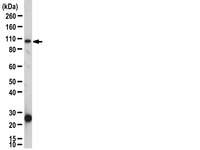07-1008 Sigma-AldrichAnti-IKKβ Antibody
This Anti-IKKβ Antibody is validated for use in WB for the detection of IKKβ.
More>> This Anti-IKKβ Antibody is validated for use in WB for the detection of IKKβ. Less<<Produits recommandés
Aperçu
| Replacement Information |
|---|
Tableau de caractéristiques principal
| Species Reactivity | Key Applications | Host | Format | Antibody Type |
|---|---|---|---|---|
| H, Ca, Ch, B, Fe, M | WB | Rb | Affinity Purified | Polyclonal Antibody |
| References |
|---|
| Product Information | |
|---|---|
| Format | Affinity Purified |
| Control |
|
| Presentation | Purified rabbit polyclonal in buffer containing 0.1 M Tris-glycine, pH 7.4, 0.150 mM NaCl and 0.05% sodium azide. |
| Quality Level | MQ100 |
| Physicochemical Information |
|---|
| Dimensions |
|---|
| Materials Information |
|---|
| Toxicological Information |
|---|
| Safety Information according to GHS |
|---|
| Safety Information |
|---|
| Storage and Shipping Information | |
|---|---|
| Storage Conditions | Stable at 2-8°C for 1 year from date of receipt. |
| Packaging Information | |
|---|---|
| Material Size | 150 µg |
| Transport Information |
|---|
| Supplemental Information |
|---|
| Specifications |
|---|
| Global Trade Item Number | |
|---|---|
| Référence | GTIN |
| 07-1008 | 04053252337444 |
Documentation
Anti-IKKβ Antibody FDS
| Titre |
|---|
Anti-IKKβ Antibody Certificats d'analyse
| Titre | Numéro de lot |
|---|---|
| Anti-IKK - 2002743 | 2002743 |
| Anti-IKK - NG1627072 | NG1627072 |
| Anti-IKK - NG1662289 | NG1662289 |
| Anti-IKKβ - 2385970 | 2385970 |
| Anti-IKKβ -2519837 | 2519837 |
Informations techniques
| Titre |
|---|
| Protein Blotting Handbook: 6th Edition |







